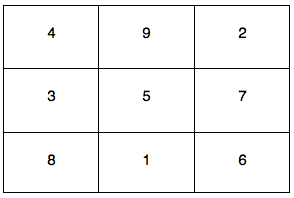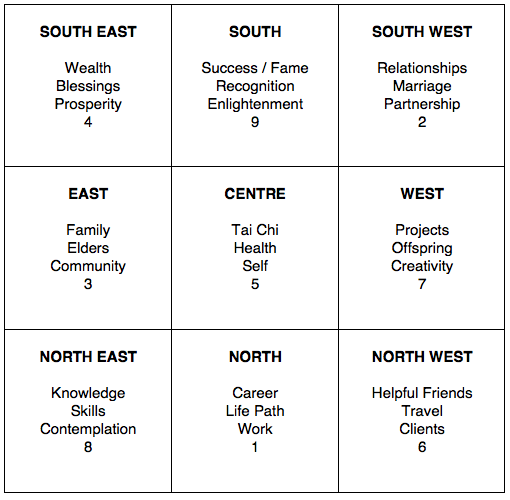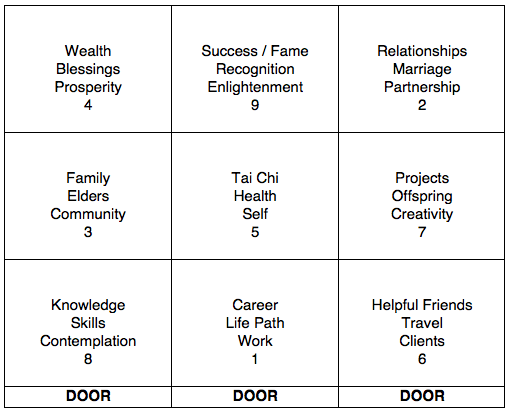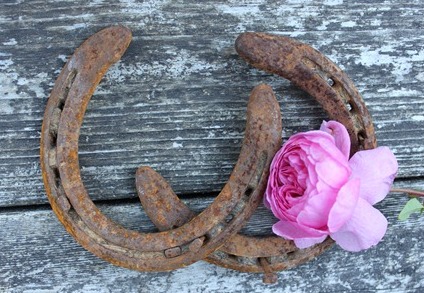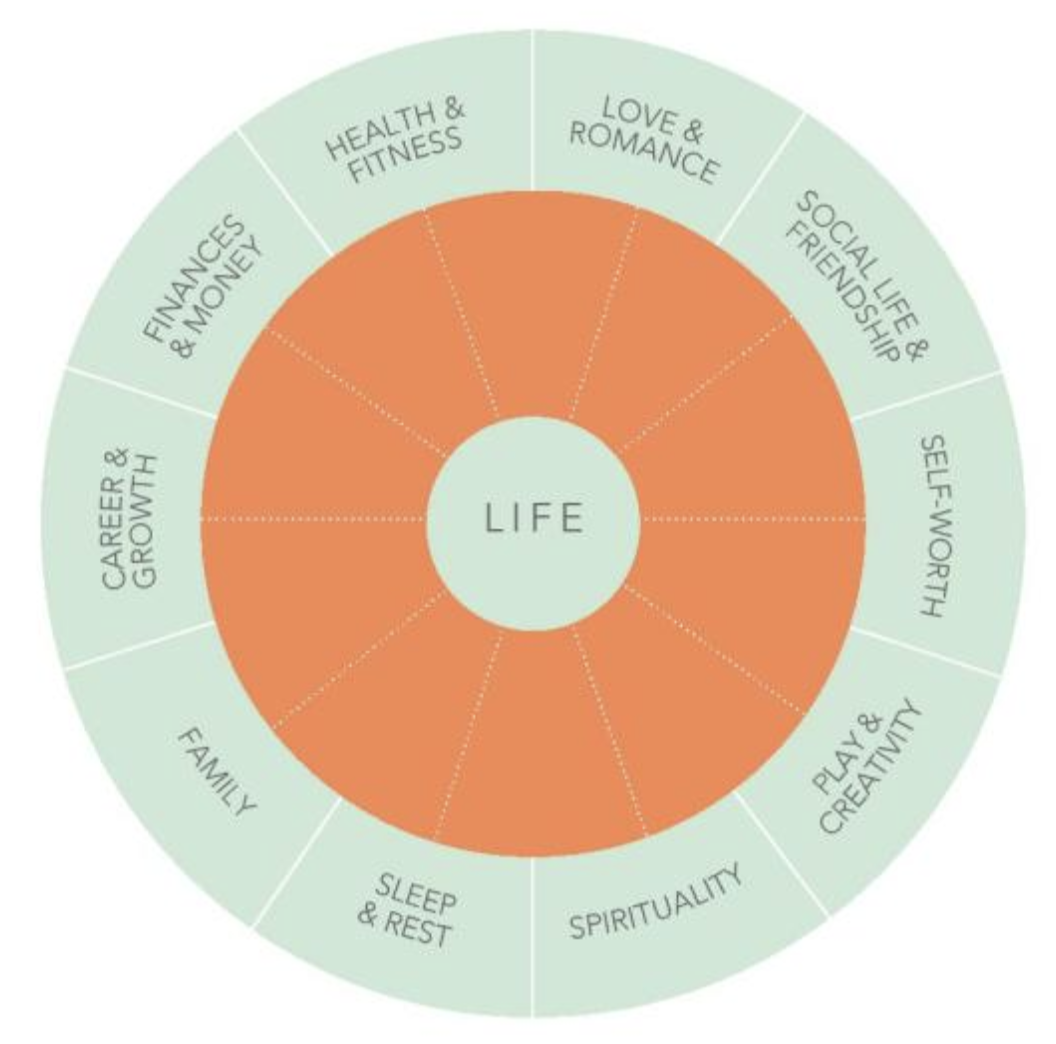What is a feng shui bagua model?
Bagua is a feng shui energetic and metaphoric matrix, a code or simulation for space harmonisation and manifestation. The bagua maps the primary aspects of our lives and values (career, relationships, wealth and so on). Simply put, bagua is a vision board for your life. It is also a map used in feng shui to locate the areas in our homes and workplaces that we can use to represent these values and life aspects. Bagua is an amplifier and a mirror of our own values, needs, wants and desires (it’s not a telescope). Balancing, activating and enhancing chi/energy in these physical areas (with lighting, pictures, plants, furniture, objects, etc) can then improve the corresponding aspects of our lives. It can be thought of as an energetic matrix of energy flow in any space. In short, bagua is an imaginary or conceptual tool or method for organising, physicalising, codifying and activating your values and manifesting your dreams and goals.
Think about bagua as your vision board.
The history behind the bagua model
Bagua is a magic square or Luo Shu and is based on trigrams from I-Ching, the Book of Changes (in both early heaven and latter heaven sequence).
How to use bagua map/matrix
To use the bagua, place it over a plan of your home/room/workspace in such a way that the door to your flat/home/room/office is at the bottom of the page in the areas of knowledge, career and helpful friends. This matrix can be used on other things such as your business card, your desk, website.
“We shape our buildings, thereafter they shape us.” Winston Churchill
Understand the difference between the two feng shui bagua schools. Two types of baguas: classic and western
There are two basic feng shui bagua schools: 1) traditional or classic compass bagua and 2) three-door gate of chi bagua. Understanding how both baguas developed over time and why will help you make an informed and empowering choice.
1. Classic / traditional compass bagua school
2. Three-door gate of chi bagua
“I understand that it (feng shui) works whether you believe in it or not.” Niels Bohr, Danish quantum physicist, Nobel Prize winner in Physics
‘Missing corners or spaces’
There is a myth about the 3-door gate bagua that if some areas of the space are kind of ‘missing’ – then you have or might have a problem with that aspect of your life. In my experience, it’s a false problem which will create a false solution. Unfortunately, once you’ve been exposed to this false problem, you’ll need a solution to counter the negative perception (nocebo effect) to feel better about your home or workplace. Basic remedies include placing a mirror to symbolically expand that ‘missing’ space, hanging a crystal, installing lights, etc. The virtual bagua (below) has no such issue; hence it’s a much superior model.
You can apply the bague on the complete floor and each room or space as well, if necessary, but that can make it all very complicated or add more opportunities for placement of feng shui remedies. Three-door gate of chi bagua is dependent on space but less restricted than the compass bagua.
3. Virtual/spiritual/archetypal/symbolic bagua
‘You can’t use an old map to explore a new world’ – Albert Einstein
Summary of the differences between classical, modern 3-gate and virtual baguas
| Type of bagua | Classical: COMPASS | Modern: 3-GATE | Modern: VIRTUAL |
|---|---|---|---|
| Orientation | Compass directions | Entrance or door | Virtual / Non-local / Anywhere |
| Power, Control & Influence | External (space) | Internal (space) | Transcendental (beyond space) |
| Mode | Physical | Mental | Energetic, Spiritual & Integral |
| Function | Realisation | Actualisation | Transformation |
| Hemispheric function | Left brain | Right brain | Whole brain |
| Remedy | Prescriptive / superstitious | Empowering / Creative | Metaphors / Archetypes / Symbols / Higher Values / High empowerment |
| Consciousness | Tribal / Ethnocentric | Rational / Pluralistic | Integral / Cosmic |
| State | Opportunity (limited) | Responsibility | Empowerment |
| Political orientation | Right | Left | Middle |
| Chakras | Lower | Middle | Higher |
| Maslow's Hierarchy of Needs | Basic needs, physiological and safety | Social and esteem needs | Self-actualisation, transcendental and spiritual needs |
| Effectiveness (results) | 'Toilet-water like' | 'Cologne-water like' | 'Perfume like' |
| Efficiency (time, speed) | Sequential, Chronos time, Quantity time, Horizontal, Slow | Semi-sequential, Chronos time moving towards Kairos, Quantity to quality time, Fast-ish | Non-linear, Kairos, Quality time, Vertical, Now, Beyond time, Timeless, Very fast |
Efficiency and timing
“Every kairos is a chronos, but not every chronos is a kairos.” said Hippocrates. So depending on how fast you want to change your life, you might want to choose the bagua model that works best for your speed of change – what’s comfortable for your development. So if you like, a slow, organic change I recommend the modern 3-gate bagua and even the classical one. But if you want fast, almost immediate change – the virtual bagua is for you.
The difference between chronos and kairos is that chronos is quantity, ‘physical’, measurable time ie sequential and linear/horizontal (measured by clocks and calendars), whereas kairos time is quality time, timeless, non-linear/vertical (evaluated by values and archetypes). Obviously, we need both chronos and kairos but in modern times people have lost the notion of kairos time. Chronos is about measuring time in seconds, minutes, days, etc (“What time is it now?”), and kairos is about evaluating it (What is it time for?) and its significance as well as opportunity ie carpe diem time. Kairos can help us ‘control’ our future by being in the flow and by affirming life and chance. Kairos allows us to collapse all possibilities and opportunities in the now moment. (Kairos is a different spelling of the Greek deity Caerus, the god of luck and opportunity). In short, kairos is luck.
I’m still confused about which method to use. Which feng shui bagua school is better?
Book a feng shui consultation for your home, business, work or personal life with Jan Cisek – call/text on +44 7956 288574 or email him
In my feng shui practice
In my 40+ years feng shui practice I’ve noticed that most people prefer the three-door gate of chi bagua because they resonate with it and want to be empowered. A very small number of individuals prefer the classical compass bagua method – usually because of upbringing, cultural preference and fate-like mindset. Sometimes they choose the compass bagua because that kind of alignment offers the best prospects for their particular house shape and compass orientation (but that is quite rare). Ultimately, there is nothing wrong with using any of those methods but understanding how they got developed helps with an informed choice. Obviously, if your home is facing north, then you don’t have to make any choice since both baguas will overlap.
The problem with classical and 3-door gate bagua is that they’re quite limited, restrictive and very often dogmatic (especially if you read feng shui nonsensical advice online). The virtual bagua overcomes their limitations through include and transcend principle. The qualities of aspects are preserved (career, relationship, wealth, etc domains) and transcend the limitation of space into symbolic representations that can be placed anywhere in your home or workplace.
Also, I want to have the vibe of prosperity in my whole home, not in just one space, the so-called ‘wealth corner’, which is very limiting thinking. When you place a symbol of prosperity with your non-local and non-linear thinking behind it – it works everywhere and every time.
WARNING: Don’t put your life into feng shui
In feng shui, we have a saying “Put feng shui into your life. Don’t put your life into feng shui.” What it means is that if you put your life into feng shui it may run it for you. You can become overly dependent on feng shui advice. You can become too concerned about making the smallest changes in your home or workplace and worried that you may make a mistake. You might create false problems for yourself and become dogmatic. You may have a tendency to blame the environment (feng shui) for your problems instead of looking at the real causes. You may feel disempowered and helpless as well as fearful of life and challenges. Use feng shui as a tool to enhance your life, to add meaningful images and symbols, reduce environmental stressors such as dirty electricity, geopathic stress, electro-smog, etc – to empower and boost your personal and professional life – and that’s what is feng shui for – to help you shape your destiny as opposed to being fated.
Bagua is an imaginary, semiotic tool – a code
Let’s be clear: there is no such a thing as a ‘wealth corner’ or ‘career area’, or ‘relationship area’, etc – they don’t exist as independent entities out there, except in our imagination. The bagua model is just a mental construct and a semiotic marking, a way of codifying space. In feng shui, we use physical space to anchor and help us to focus on our values, needs and wants. The way bagua works is the same as a placebo works ie it helps us to activate and cultivate our innate resources and connects us with the energies of life. There is no right or wrong way of using bagua. One is not better than the other. It depends on where you’re coming from, where you are in your life, at what stage in your personal growth, your preferences, your cultural heritage, your mindset and what works for you. Read more about how feng shui works
The Wheel of Life in life coaching – bagua for life
In life coaching, there is a similar concept to bagua, called the wheel of life and it covers more or less the same life domains such as:
• health & fitness
• love & romance
• social life and friendship
• self-wealth
• play & creativity
• spirituality
• sleep & rest
• family
• career & growth
• finances and money
without referencing them in space or environment. They’re mental constructs or values that are important to people. In feng shui, these values are externalised into an environment to give people more clarity and focus, and to help with actualising them.
In her book Happy Starts at Home: Change your space, transform your life, Rebecca West bases her suggestions for home improvements based on the wheel of life model.
How to activate different aspects of your bagua
That depends on your needs and wants. There are many feng shui interventions that can be used to do the job. For example, light, plants, water features, elements, symbols, pictures and images and so on. Whatever you choose should resonate with your preferences, your belief system and the deco of your home and workplace. There are no hard rules how to use feng shui remedies for activation of the bagua areas – just use whatever works.
To sum up – you have a choice
It’s all about choice and self-empowerment as well as control. Do you want to analyse and interpret your life or do you want to change and build it? Feng shui bagua model is just a code or map and it’s up to you and your changing circumstances how it’s going to work for you.
Answer these questions:
1) do you want to follow your fate or
2) do you want to shape your destiny?
If you want to follow a traditional feng shui then choose the compass bagua. If you want to empower your life and take control of your environment to choose three-door gate of chi bagua or virtual/spiritual/archetypical bagua. Or combine them all. There is no conflict in using all of them at once if you don’t mind the complexity. There is no right or wrong way of using them, similarly, as Indian or Chinese cuisines are no better than French or Italian ones. It’s up to you, your preference, values, your political orientation, your consciousness and your creativity.
A person-centred feng shui is very clear on this:
1) use what works for you,
2) use what is empowering you
3) use what’s in your control and
4) use whatever helps you grow, develop and thrive.
Find out more about the difference between classical feng shui and modern feng shui

